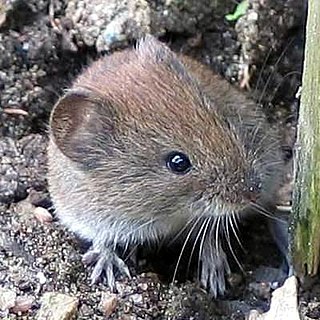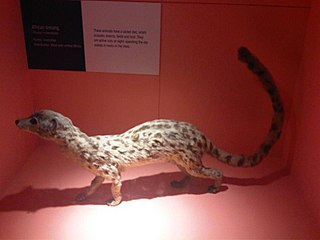
The Arctic fox, also known as the white fox, polar fox, or snow fox, is a small species of fox native to the Arctic regions of the Northern Hemisphere and common throughout the Arctic tundra biome. It is well adapted to living in cold environments, and is best known for its thick, warm fur that is also used as camouflage. It has a large and very fluffy tail. In the wild, most individuals do not live past their first year but some exceptional ones survive up to 11 years. Its body length ranges from 46 to 68 cm, with a generally rounded body shape to minimize the escape of body heat.

The curlew sandpiper is a small wader that breeds on the tundra of Arctic Siberia.

Franklin's ground squirrel is a species of squirrel native to North America, and the only member of the genus Poliocitellus. Due to the destruction of prairie, the populations of Franklin's ground squirrel have dwindled, approaching levels of concern. Its decline in the eastern portion of its range is mostly attributed to habitat fragmentation.

The Arvicolinae are a subfamily of rodents that includes the voles, lemmings, and muskrats. They are most closely related to the other subfamilies in the Cricetidae. Some authorities place the subfamily Arvicolinae in the family Muridae along with all other members of the superfamily Muroidea. Some refer to the subfamily as the Microtinae or rank the taxon as a full family, the Arvicolidae.

The tundra shrew is a small shrew found in Alaska, the northern Yukon Territory, the MacKenzie Delta region of the Northwest Territories, extreme northwestern British Columbia and eastern Russia. At one time, this animal was considered to be a subspecies of the Arctic shrew.

The sagebrush vole is a tiny vole found in western North America. It is the only member of the genus Lemmiscus.

The North American water vole or just water vole is the largest North American vole. It is found in the northwestern United States and southern parts of western Canada. This animal has been historically considered a member of genus Arvicola, but molecular evidence demonstrates that it is more closely related to North American Microtus species. Water voles are on the USDA Forest Service Region 2 sensitive species list because they maintain very small populations and there is high concern that their required habitat may be declining.

The northern bog lemming is a small North American lemming. It is one of two species in the genus Synaptomys, the other being the southern bog lemming. It is sometimes placed in its own genus, Mictomys.

The tundra vole or root vole is a medium-sized vole found in Northern and Central Europe, Asia, and northwestern North America, including Alaska and northwestern Canada. In the western part of the Netherlands, the tundra vole is a relict from the ice age and has developed into the subspecies Alexandromys oeconomus arenicola.

The southern bog lemming is a small North American lemming. Its range overlaps with the other species in genus Synaptomys, the northern bog lemming, in southeastern Canada, but extends farther south.

The Ungava collared lemming or Labrador collared lemming is a small North American lemming.

The northern collared lemming or Nearctic collared lemming, sometimes called the Peary Land collared lemming in Canada, is a small lemming found in Arctic North America and Wrangel Island. At one time, it was considered to be a subspecies of the Arctic lemming. Some sources believe several other species of collared lemmings found in North America are actually subspecies of D. groenlandicus.

The bank vole is a small vole with red-brown fur and some grey patches, with a tail about half as long as its body. A rodent, it lives in woodland areas and is around 100 millimetres (3.9 in) in length. The bank vole is found in much of Europe and in northwestern Asia. It is native to Great Britain but not to Ireland, where it has been accidentally introduced, and has now colonised much of the south and southwest.

The Japanese hare is a species of hare endemic to Japan. In Japanese, it is called the Nousagi, meaning "field rabbit".

The Arctic ground squirrel is a species of ground squirrel native to the Arctic and Subarctic of North America and Asia. People in Alaska, particularly around the Aleutians, refer to them as "parka" squirrels, most likely because their pelt is good for the ruff on parkas and for clothing.

The Canadian lemming or Nearctic brown lemming is a small North American lemming.

The Central African oyan, also called Central African linsang, is a linsang species native to Central Africa.

Dicrostonyx is a genus of rodent in the family Cricetidae. It contains the collared lemmings or varying lemmings. They are the only North American rodents that turn completely white in winter. It contains the following species:

The Arctic lemming is a species of rodent in the family Cricetidae.

A lemming is a small rodent, usually found in or near the Arctic in tundra biomes. Lemmings form the subfamily Arvicolinae together with voles and muskrats, which form part of the superfamily Muroidea, which also includes rats, mice, hamsters, and gerbils. In popular culture, a longstanding myth holds that they exhibit herd mentality and jump off cliffs, committing mass suicide.





















